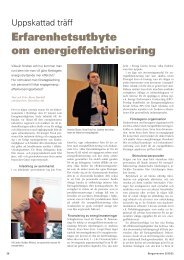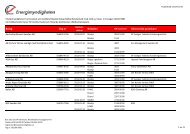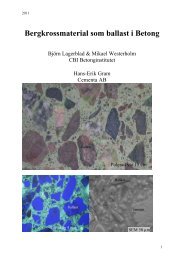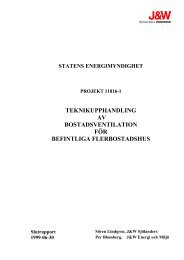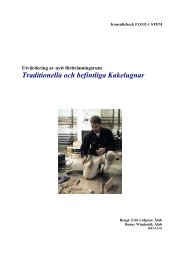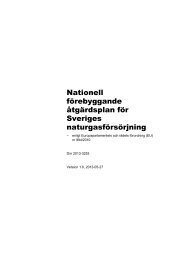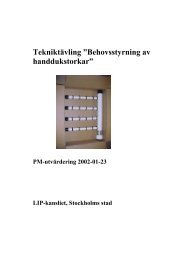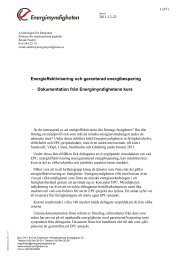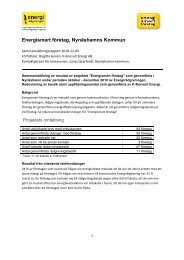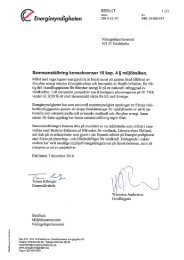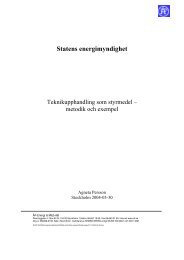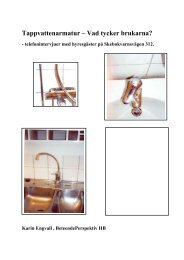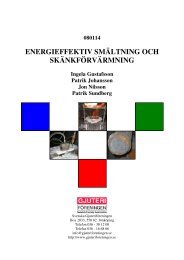ATAC i system - Energimyndigheten
ATAC i system - Energimyndigheten
ATAC i system - Energimyndigheten
You also want an ePaper? Increase the reach of your titles
YUMPU automatically turns print PDFs into web optimized ePapers that Google loves.
Project goal:<br />
The overall objective is to investigate the feasibility of enhancing the performance for smallscale<br />
steam turbines (less than 25 MWel) by means of aero-thermodynamic calculations and<br />
experiments. An improved understanding of partial admission losses in low flow rate<br />
turbomachines is one specific goal. Results may be used as design criteria for small-scale<br />
steam turbines, possibly with advanced steam data. Another general objective is to increase<br />
the physical understanding of partial admission losses in small flow rate turbomachines in<br />
order to improve future design and choice of partial admission in small-scale steam turbines,<br />
possibly with advanced steam conditions.<br />
Preliminary date for a Licentiate exam is May/June 2003.<br />
Methodology:<br />
In order to meet the project goals, numerical calculations combined with experimental tests in<br />
a cold-flow air turbine test facility at KTH are planned. Applying partial admission induces<br />
additional losses and an attempt will be made to investigate these losses, with an emphasis on<br />
the physical understanding of the flow mechanisms. The approach will be conduct partial<br />
admission tests on the two-stage axial air test turbine at HPT, and one-dimensional mean-line<br />
calculations will be performed with ALSTOM’s in-house code AXIAL. A highly loaded onestage<br />
object will also be investigated. The calculation results will be used to determine if the<br />
existing test object can be used for simulating partial admission and/or advanced steam<br />
conditions for small flow rate steam turbines. If the answer to this is positive, then the<br />
experimental measurements will be performed.<br />
Results:<br />
Corresponding sub-phases are presented in the time plan (see below):<br />
Sub-phase 1.a<br />
Small-scale steam turbines almost exclusively employ admission data below 540°C/140 bar.<br />
The main problem with applying high-temperature steam is located to the boiler <strong>system</strong>,<br />
where the problem consists of finding a cost-efficient and suitable material for superheaters,<br />
piping etc. Steam parameters above 600°C exist today in large-scale generation and it is<br />
technically feasible to incorporate these temperatures into small-scale generation although it is<br />
economically questionable for pure Rankine cycles. However, small-scale combined cycles<br />
with advanced steam parameters gives a more positive overall picture. A limited number of<br />
publications regarding experimental and numerical studies about partial admission losses have<br />
been found in the open literature, with still limited physical understanding of the flow<br />
phenomena during partial admission. This points towards a continuation of the project with<br />
complementing experiments.<br />
Sub-phase 1.b<br />
Participating in external turbine trials at DLR (Germany) and at KTH has lead to valuable<br />
knowledge that can be used when turbine trials become current. The student is able to run the<br />
test facility at KTH. Various courses and collaborations with national- and international<br />
companies, research institutes and universities have broadened the knowledge about<br />
aerothermodynamics of small-scale steam turbines.



